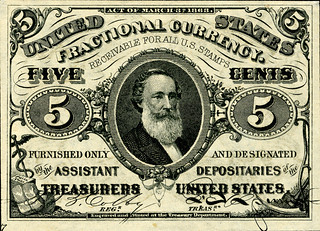
PREV ARTICLE
NEXT ARTICLE
FULL ISSUE
PREV FULL ISSUE
SPENCER CLARK'S FRACTIONAL NOTE PORTRAIT
Another Atlas Obscura article this week is of interested to numismatists for a different reason - it's focused on Spencer Clark and the 3rd Issue 5 cent fractional currency note that bears his portrait.
-Editor
Clark, who served as Superintendent from 1862 to 1868, had no authorization from his superiors to do this. But U.S. paper bills were in flux because of the recent introduction of fractional money, and as the supervisor of the new bills, he was in a unique position to influence the design. From 1862 to 1876, the U.S. Treasury issued fractional money to combat a growing coin shortage. “At the beginning of the Civil War,” according to the website Antique Money, “people started hoarding coins for their precious metal content.” To avoid a crisis, the Treasury introduced paper money to represent a cent amount rather than a dollar amount. These fractional bills were physically smaller than dollars and consisted of three-cent, five-cent, 10-cent, 25-cent, and 50-cent notes. It was the third issue of that five-cent note that caught Clark’s attention. Congress had asked for the note to honor William Clark of the Lewis and Clark explorations. But allegedly, the document that reached the Treasury specified only that the new bill should honor “Clark,” without clarifying which one—and Spencer M. Clark, despite surely knowing Congress’s true intention, seized the opportunity to print his own face on the bill. The move infuriated Congress. Clark was already roundly disliked because of the scandals he had brought the federal government. Two years earlier, in 1864, the House of Representatives investigated his department after Representative James H. Brooks claimed the Treasury had become a “house for orgies and bacchanals.” Clark was accused of “hiring women based on their looks rather than their ability”; female employees described how he “plied [them] with oysters and ale and made ‘improper’ overtures to them.” In fact, one woman told Congress that he had “offered her first $100, then 10 times that amount, for a tryst with her.” (An investigating body, however, concluded that these claims had no basis and that Clark was the victim of a “conspiracy.”) By the time he printed his own face on U.S. money, Congress had little patience remaining. One Congressman in particular—Pennsylvania Congressman Russell Thayer—”took immediate exception” to Clark’s five-cent note when he learned of it in February 1866. That March, he amended an appropriations bill to say “hereafter no portrait or likeness of any living person shall be engraved or placed upon any of the bonds, securities, notes, or postal currency of the United States.”
To read the complete article, see:
The Numismatic Bibliomania Society is a non-profit organization promoting numismatic literature. See our web site at coinbooks.org. To submit items for publication in The E-Sylum, write to the Editor at this address: whomren@gmail.com To subscribe go to: https://my.binhost.com/lists/listinfo/esylum All Rights Reserved. NBS Home Page Contact the NBS webmaster 
|
